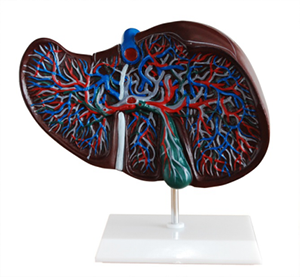

Article tag: Liver anatomical model| Organ anatomical model| BIX-A1054|
The liver anatomy model can meet the long-term development needs of medical training, especially in improving anatomical understanding, clinical diagnostic ability and surgical skills. As the market demand for medical simulation devices increases, liver anatomical models will continue to play an important role in the field of medical education. Combined w...
With the gradual transformation of medical education to skill orientation, medical simulation has become an important teaching method. Traditional anatomy teaching methods, such as autopsy and atlas learning, have certain educational value, but it is difficult to meet the requirements of intuitiveness, operation and diversification in modern medical education. The emergence of the liver anatomical model has filled this gap, which not only provides a clear anatomical structure, but also simulates the pathological changes of the liver, helping students better understand the disease and how to deal with it.
According to the market research report, the global medical education simulation market is expected to grow by approximately 10% over the next five years, with liver anatomy models accounting for a significant proportion of demand in medical education. This growth is mainly due to the increased demand for simulation equipment in various medical institutions, medical schools and clinical training centers, especially in the context of the high incidence of liver diseases (such as hepatitis, cirrhosis, liver cancer, etc.), and the increasing demand for liver anatomy teaching and surgical training.

Industry expert opinion: Technology innovation and education demand driving growth
Industry experts generally agree that liver anatomical models will play an increasingly important role in medical education in the future. The development of medical simulation technology, especially the introduction of 3D printing, virtual reality (VR) and augmented reality (AR) technology, has greatly expanded the functions of liver anatomical models. Through these technologies, the liver anatomy model can provide a more detailed and personalized training platform, allowing students to perform simulation exercises such as liver surgery and liver disease diagnosis in a virtual environment, thereby greatly improving their clinical skills.
For example, with the widespread development of liver transplantation and minimally invasive surgery, the refinement and fidelity of liver anatomical models have also improved. These models can provide surgeons with realistic surgical rehearsals, helping them familiarize themselves with surgical procedures, anatomical areas, and possible complications. For this reason, many experts believe that the application of liver anatomical models is the key to the development of efficient and accurate medical education.
Data support: Effects of liver anatomical models in education
The data show that students who use the liver anatomical model for medical training have significantly improved their ability in liver disease diagnosis and surgical operations. A study by a medical education institute showed that students who participated in liver anatomy model training scored about 30 percent higher on liver anatomy exams than students who learned the traditional way. In addition, in the clinical diagnosis and treatment of liver diseases, students using the model were able to improve the diagnostic accuracy by more than 20% compared with their classmates who did not use the model.
In surgery, a study of simulated training of surgeons showed that doctors who simulated surgery using a model of liver anatomy had a 15 percent increase in surgical success and a 10 percent decrease in postoperative complications. These data show that the liver anatomy model not only improves students' theoretical level, but also plays an irreplaceable role in practice.
Future prospects: The long-term development potential of liver anatomical models
As medical technology continues to advance, liver anatomical models will continue to evolve and become an indispensable tool in medical training. Future liver anatomy models will be more intelligent, personalized, and incorporate artificial intelligence (AI) technology to provide real-time feedback and personalized training recommendations, further improving the quality and efficiency of medical education.
In addition, as the incidence of liver diseases worldwide increases year by year, the market demand for liver anatomical models will continue to grow. The complexity and diversity of liver diseases require medical students and clinicians to have higher diagnostic and surgical capabilities, so liver anatomical models will play a greater role in medical education and clinical training.
conclusion
The liver anatomy model can meet the long-term development needs of medical training, especially in improving anatomical understanding, clinical diagnostic ability and surgical skills. As the market demand for medical simulation devices increases, liver anatomical models will continue to play an important role in the field of medical education. Combined with emerging technologies and refined design, liver anatomy models will play a more important role in medical training in the future, helping to train medical talents and promote the progress of medical technology.